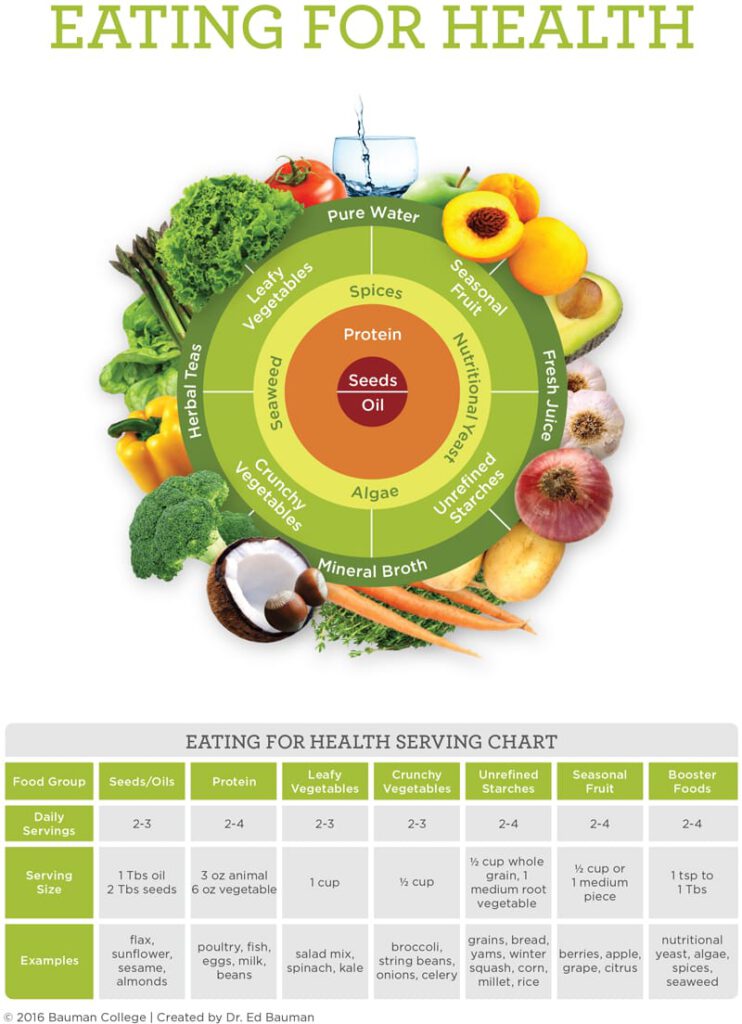Eating for Health® is a way of life. It reflects a relationship to food based on consciousness, gratitude, sound science, and positive energy. ~ Dr. Ed Bauman
Eating for Health® is a system—not a diet—developed by Dr. Ed Bauman, as an alternative to the United States Department of Agriculture’s (USDA) dietary recommendations and other one-size-fits-all dietary approaches. It seeks to strategically develop food plans for people rather than having them eat according to a food model that has worked for some but not all people; it also serves to clear up the confusion engendered by the vast array of supposedly very different popular diets. It features fresh, whole foods that align with people’s needs, preferences, and ethnic and cultural backgrounds, with attention paid to changes in seasons, situations, aging, and health challenges.
The goals of this unique system are first to provide optimal amounts of macronutrients (proteins, fats, and carbohydrates), micronutrients (vitamins and minerals), phytonutrients (plant alkaloids with protective value), and other vital factors (enzymes, tastes, energetic properties) that can be most efficiently digested and assimilated. Eating for Health® also seeks to teach people about the intrinsic pleasures to be gained from choosing nutritious foods and eating them mindfully and with gratitude, which allows for better digestion and assimilation of nutrients along with a sense of having nourished oneself not only physically but emotionally and spiritually as well.
In Eating for Health®, we embrace two powerful maxims—“food is the best medicine” and “know thyself”—and create a synergy that opens the way to wellness and service.
The Eating for Health® model provides a map for healthful eating that draws on a wide array of traditional and modern dietary principles and practices. It aims to teach people to better understand how the chemicals, additives, processing, packaging, and preparation of much of the food they have eaten has contributed to diminished health while providing guidelines that encourage people to create and enjoy meals based upon fresh, whole foods that suit their cultures, ethnicities, budgets, and preferences. Genetics, biochemistry, psychology, physiology, age, and sensitivities all influence one’s optimal food choices. Clearly, one size does not fit all when it comes to nutrition. It never has and never will.
Consider the foods that were nourishing and healing in the past as well as the foods that are currently relied on for energy or emotional gratification. If these foods are loaded with stimulants, damaged fats, and sugar or artificial sweeteners—ingredients that will sabotage a person when the momentary distraction wears off, pleasure fades, and disease takes over—the journey to eat for health can begin by choosing fresh, seasonal, chemical-free, nutrient-rich, organic foods that replenish the reserves that have been drained by poor-quality foods.
Teaching people how to make more conscious food decisions is how nutrition consultants and natural chefs support people in achieving well-being. Rather than treating disease solely with medical procedures and pharmaceuticals, the Eating for Health® approach is to share current, non-biased research on the health benefits of whole foods, botanicals, nutrient supplementation, lifestyle, and exercise to enable individuals to recognize that they have great power in what they choose to eat, which will impact their energy, mood, body composition, and the quality and duration of life.
EATING FOR HEALTH® REMINDERS
- Increase your intake of local, seasonal, fresh, organic foods.
- Drink plenty of purified water and herbal tea each day.
- Minimize caffeine intake to 50 mg or less (1 cup black tea, 3 cups green tea, or 1/2 cup coffee or espresso) per day.
- Eat protein by 10 a.m. and 1-3 more times during the day to curb your sweet tooth.
- Decrease your intake of refined and artificial sugars; white-flour products; unnatural fats; and added hormones, preservatives, colors, and antibiotics.
- Diversify sources of proteins, fats, and carbohydrates.
- Eat more monounsaturated fat (olive, avocado, almond) than saturated fat (animal, dairy, coconut) or polyunsaturated oil (soy, corn, sunflower).
- Decrease your consumption of gluten-containing grains (wheat, rye, barley, etc.) to prevent digestive disturbance and inflammation.
- Eat 3 portions of vegetables in a meal to 1 serving of protein and 1 serving of fat.
- Enjoy your food and let others eat in peace.
HOLISTIC NUTRITION + KEYS TO HEALTH, HAPPINESS, + LONGEVITY INCLUDE:
- Eat well every day.
- Maintain a positive attitude.
- Stretch, move, and breathe deeply throughout the day.
- Connect with your own true self.
- Align with others with positive values.
- Connect with the source through service, spiritual practice, and love of life.
- Be a lifelong learner and activist.
You are the co-creator in the Eating for Health® process, and we invite you to create a delicious path to health and vitality through the goodness of whole-foods nutrition, enjoyable physical movement, and connection to community.

The Eating for Health® model provides a palette from which we can select the most health supportive foods. Eating from the inside out will provide a building diet for times when we need to build up our nutrient reserves. Eating from the outside in will set the scene for cleansing the body of impurities and toxins. The goal of the Eating for Health® model is to provide a diverse selection of whole foods to sustain health and promote recovery from illness and injury.